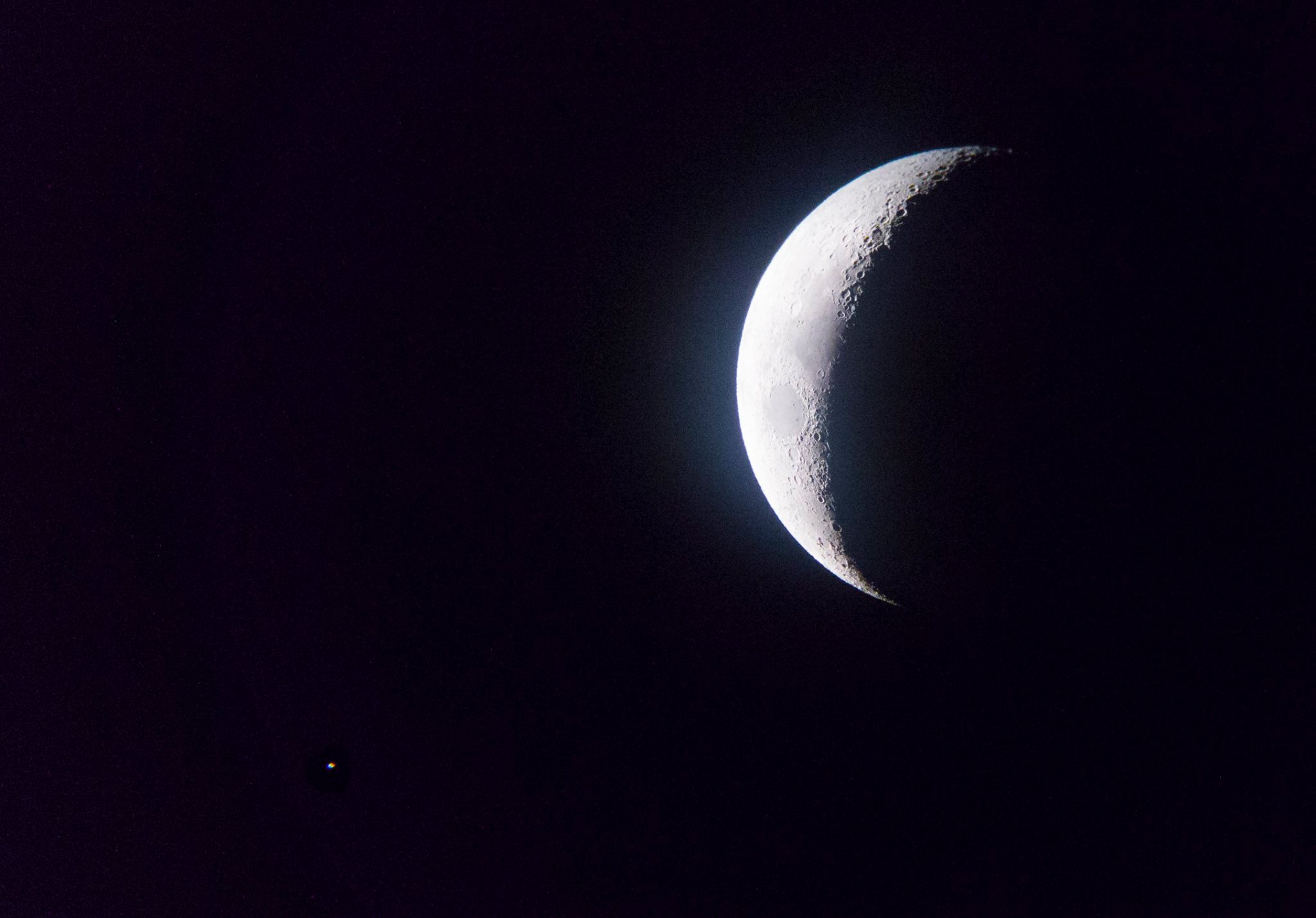
| Observer: | Tom Campbell |
| Location: | College Station, Texas (Long: 96°17'W Lat: 30°37'N) |
| Telescope: | Zhumell 12" f/5 Dobsonian |
| Eyepieces: | Explore Scientific 18mm (83x) Explore Scientific 11mm (136x) |
| Lenses: | Celestron Luminos Barlow (2.5x) |
| Weather: | The sky was clear and transparent, although there was a lot of atmospheric turbulence. Stars were twinkling wildly. Temperature was in the 80s (F). |
As my wife and I were ending our sunset walk, our neighbor was outside and waved us over to his house. The skies had cleared nicely and the crescent Moon was smiling at us. He asked if I had seen the bright star next to the Moon the previous night.
Indeed, I had. "That was Regulus," I explained. "It made for a gorgeous pairing with the Moon. I even managed to take a photo of it."

Then he pointed up to the darkening sky and asked if I knew where the "crown" constellation was. I said, "You probably mean Corona Borealis. It is also known as the Northern Crown." He agreed that this was probably right and mentioned that he remembered growing up in a small town and being able to see it in his sky as a child.
I quickly scanned the slowly darkening sky. There was Arcturus, high overhead. After a few seconds, I could see enough stars to make out the general outline of Bootes. Using that as a guide, I looked to where Corona Borealis should be. Only a couple of stars there were barely visible.
I showed him the general area, and explained that the sky needed to get a bit darker first, but if he wanted, I could show it to him a little later.
So as soon as we had finished with our walk, I decided to pull out the Biggie Z. I was debating whether to set it up in the driveway so I could let our neighbor look at a few things, or set it up in the back yard so I could take advantage of the clear skies and do some serious observing.
I mentioned the dilemma to my wife. Without hesitation, she said, "You better set it up in the driveway. You told our neighbor you would show him the sky."
Of course, she was right, and I rolled the telescope out to the end of the driveway where I could catch a glimpse of Saturn climbing up over my roof. I got everything set up and called my neighbor over.
Using my laser pointer, I traced the outline of Corona Borealis for him. We were still in twilight and he was having trouble picking out more than a few of its stars. He said, "Let me go get my binoculars!" and came back a few minutes later, trying to find those stars.
He knew where the Big Dipper was, so I pointed out a few other constellations to him. When I showed him Scorpius, he said, "Wow, I never knew it was so big!"
Then he said, "What's that triangle of stars over there?" I thought he might be referring to the Summer Triangle, but he wasn't pointing in quite the right direction. I handed him my laser pointed and asked him to show me. He aimed at a few stars. "Oh! That's part of Hercules." I took the laser pointer back and pointed out the constellation. "There's the head over there, and those two stars are the shoulder. And these four stars make up what I call his kilt. And about here, on the side of the kilt, is a large cluster of stars."
He looked through his binoculars while I kept the laser aimed at M13. "I can't see it," he said, disappointed.
"That's okay," I replied. I'll show it to you through the telescope." The cooling fan had been running long enough now that most of the larger tube currents should have settled down. "But first, would you like to see Jupiter?"
Who says no to that? We both took a good look. Although the Great Red Spot was on the far side of the planet, all four of the Galilean moons were visible, with three huddled together near one side of Jupiter and the other one close to its other side.
He was impressed. I said, "Would you like to see Saturn, too?" He answered that he had only seen Saturn in photographs, so I quickly aimed the telescope and had him take a look.
"Wow, you can really see the rings!"
"Yes, aren't they beautiful? You'll notice a star over on one side of the planet. That's Titan, one of Saturn's moons."
"Nice!"
Next, I decided to show him M13, since I had mentioned it earlier. "That's about 300,000 stars, all grouped together."
He said, "M13. That's one of our neighboring galaxies, right?"
I said, "No, M13 is a globular cluster in our own galaxy. You're probably thinking of M31. It has a similar name."
"Oh, okay."
I then grabbed my laser pointer again and showed him the outline of Cygnus. I said, "Some people see this as the Northern Cross, and some people call it the Swan." I pointed out the outline of both and then pointed the telescope towards Albireo. He liked the double star. I asked him what colors he saw. He said he has a hard time with seeing colors in a telescope, but said that one looked white and the other one slightly green.
I always see yellow and medium blue when I look at this pair. It is interesting the different colors that people see when looking at the same thing through the same instrument.
At this point, he thanked me for showing him everything through the telescope and went home. I looked at the sky. It sure was pretty tonight, even with the Moon trying to obscure everything. From my driveway, Scorpius and Sagittarius were right between my house and my neighbor's house. I grabbed my phone and snapped a few 30-second exposures.
I didn't like the framing of the shots, but it did reveal a hint of the Milky Way, which got me excited. I quickly went into the back yard. Yes! I could actually see the brighter parts of the Milky Way with my naked eye tonight! This has only happened a few times since I've lived here.
I packed up my telescope from the driveway and hauled it to the back yard for the rest of my observing session. I wasn't going to let a night like this go to waste.
While I was setting up again, I snapped a few more shots of the Milky Way from my back yard.
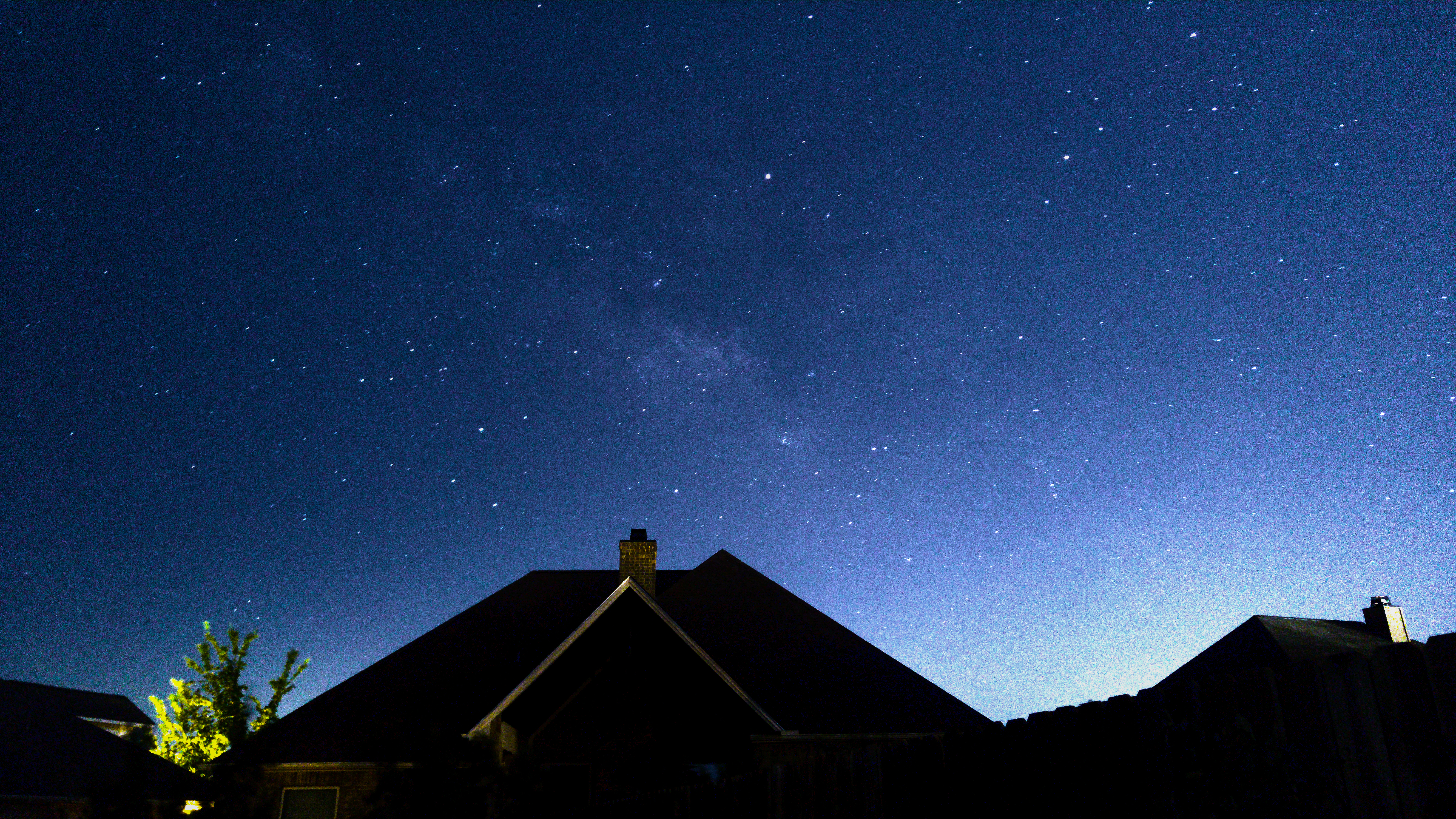
Scorpius was so gorgeous and well-placed, I decided to open up my Pocket Sky Atlas and see what celestial delights I could find there.
| Cr 338 | Scorpius | Open Cluster | 10:05pm CDT |
 |
This is a wide, loose open cluster. It is roughly hexagon-shaped, with a few brighter stars along one side. With my 18mm eyepiece (83x), it takes up about half the field, with a dozen or so stars altogether. |
||
| NGC 6441 | Scorpius | Globular Cluster | 10:15pm CDT |
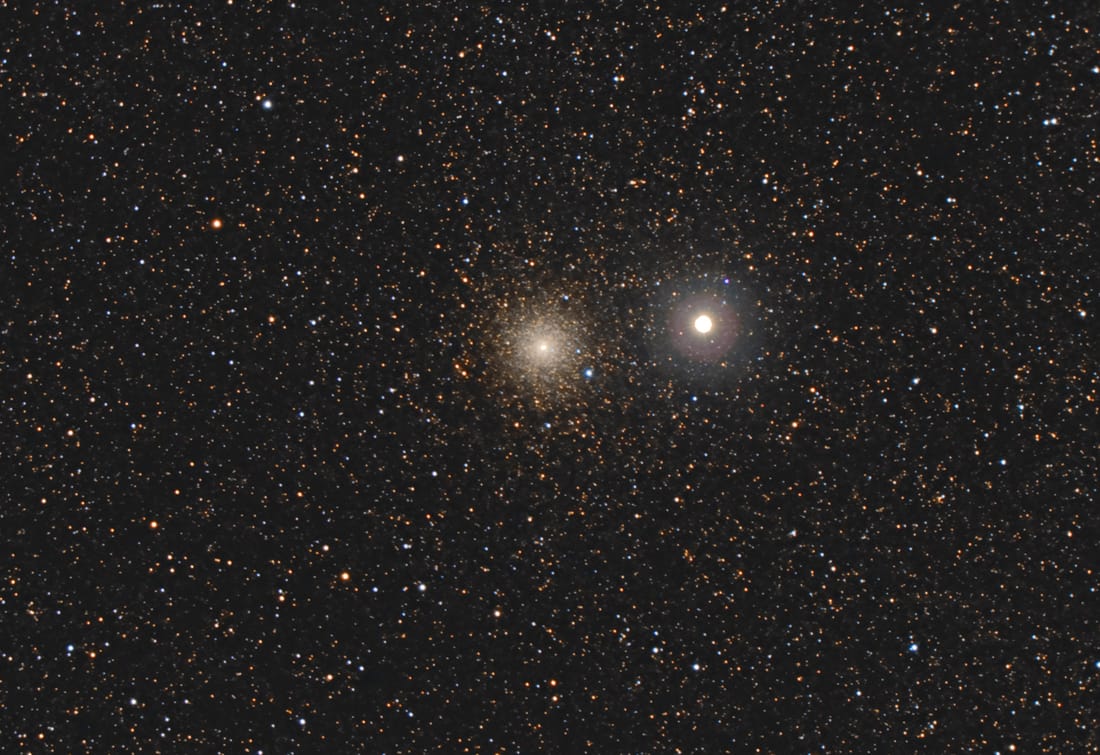 |
This a tiny globular cluster located near the bright yellow star G Sco. There is another fainter star between G and the cluster. The globular has a fuzzy appearance and a stellar core pops out occasionally with averted vision. The best view was with my barlowed 18mm (208x). |
||
| M 7 (Ptolemy's Cluster) | Scorpius | Open Cluster | 10:25pm CDT |
 |
Even with my 18mm, it fills the field. Dozens of bright stars with some fainter stars interspersed. Most of the stars appeared white or blue-white, but there was a bright yellow star near the center of the cluster. |
||
| NGC 6453 | Scorpius | Globular Cluster | 10:40pm CDT |
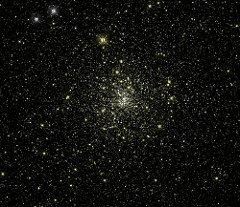 |
This is a very faint cluster, even with my barlowed 18mm. It looks like a faint, fuzzy star, and no individual members could be resolved. It is pretty easy to find by following one of the arcs of stars out to the edge of the cluster. |
||
| NGC 6444 | Scorpius | Open Cluster | 10:50pm CDT |
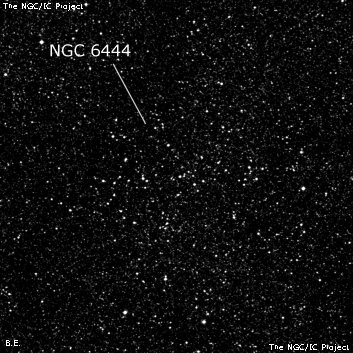 |
This cluster contains several faint stars, just on the edge of detection. The cluster is rich and fairly compact, with about 20 stars visible, of magnitude 10 or so. The cluster is irregular shaped, but somewhat elongated. The best view was with my barlowed 18mm eyepiece. |
||
| NGC 6302 (Bug Nebula) | Scorpius | Planetary Nebula | 11:35pm CDT |
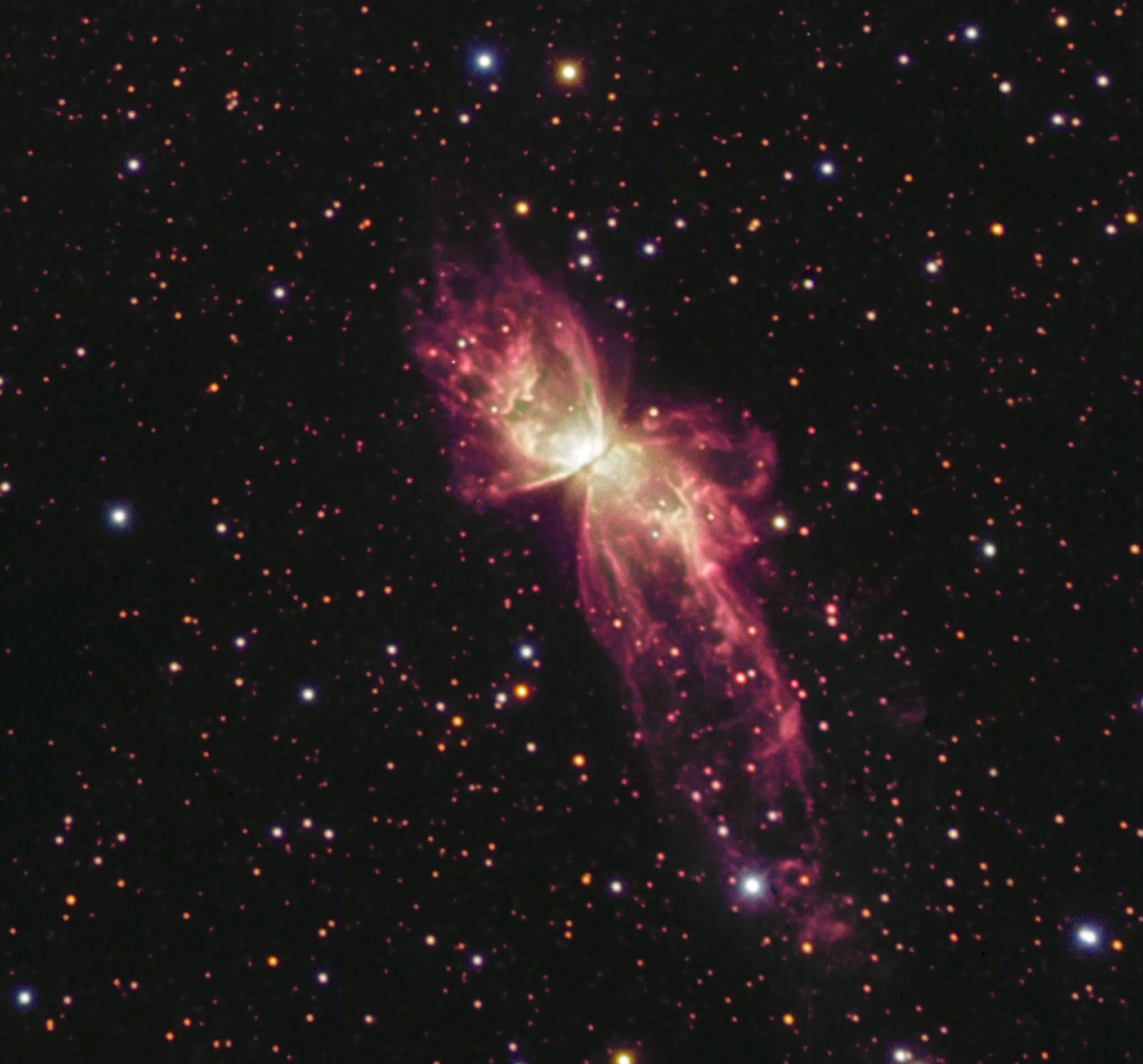 |
Using my barlowed 11mm (341x), the planetary was fairly large. There is a bright core that sharply drops off with a larger fainter nebulosity surrounding it. It is difficult to determine the shape tonight, but it is very elongated. |
||
| NGC 6231 | Scorpius | Open Cluster | 11:45pm CDT |
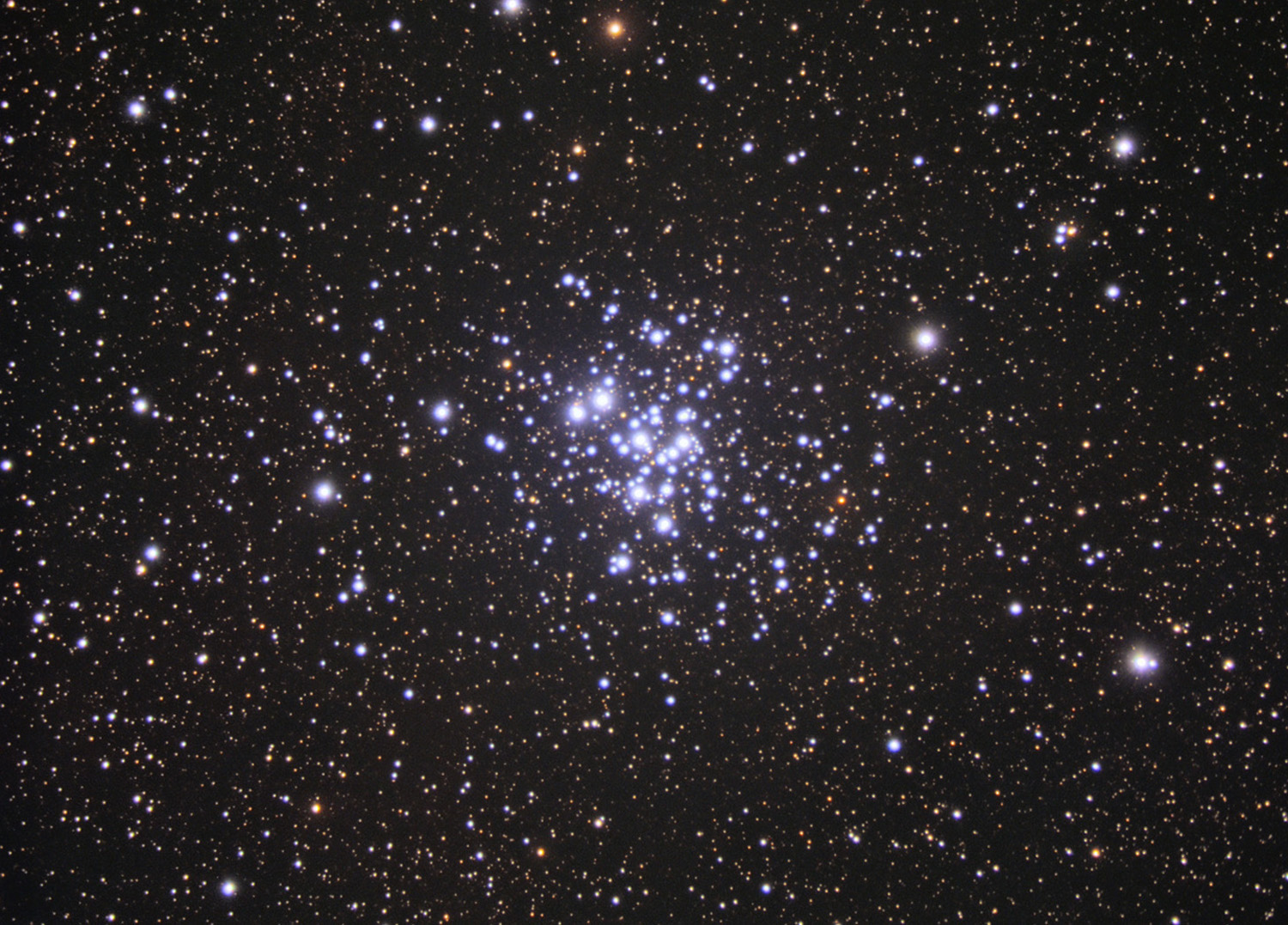 |
This is a beautiful open cluster, with many stars somewhat tightly packed. It has an irregular shape. I enjoyed the low-power view of my 18mm eyepiece on this one. |
||
| NGC 6242 | Scorpius | Open Cluster | 11:50pm CDT |
 |
This is another gorgeous open cluster with a lot of close, bright stars. It's not quite as bright or as big as NGC 6231, but still pretty in its own right. At 83X, I could see about 20-25 stars. |
||
I wish I could have stayed out a couple more hours, but this was a weeknight so I reluctantly packed it in. Besides, after taking all the photos tonight and then recording my observations, my phone battery was dead. It was great to finally get in an observing session this month.